Review: LG Stylo 3 for Boost Mobile
Mar 23, 2017, 7:15 AM by Eric M. Zeman
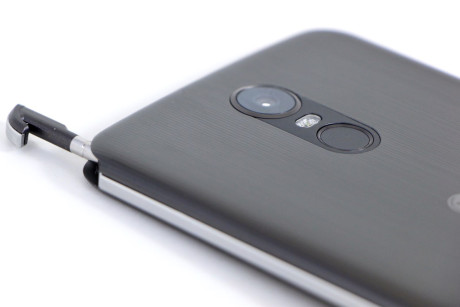
LG's third-generation Stylo for Boost Mobile includes a large screen, stylus, big battery, and advanced software. This mid-range Android handset delivers an uneven experience, but there's middle ground to appreciate. Here is PhoneScoop's in-depth review.
Hardware
Is It Your Type?
The Stylo 3 from LG is for people who may want a stylus with a big-screened phone on the cheap. This handset mimics many features of Samsung's Galaxy Note series at half the cost, which is why it's available from the likes of Boost Mobile.
Body
The Stylo 3 carries over many of the features that made its predecessors successful while making appreciable improvements along the way.
LG kept the Stylo 3's design rather conservative. It's a big slab — mostly black — made from a combination of glass and plastic. The side edges are formed by two chrome-colored plastic strips. I wish the chrome strips extended across the top and bottom edges to give the phone a more cohesive look. The front is glass, the back is plastic.
The phone's 5.7-inch display mandates a rather big footprint, which means the Stylo 3 is tall and wide. Aside from being slightly heavier, the Stylo 3 is essentially the same in terms of size and usability as last year's Stylo 2. It's a two-handed phone. Of course, using the stylus necessitates two hands unless you place the phone on a desk or table. The phone is slim enough that you can fit it into most pockets, but you'll know it's there as you move around.
LG selected okay materials for the Stylo 3, though it's obviously no flagship. The glass covering the display feels good, but the plastic along the side edges and rear surface are not the best. The phone comes across like the mid-range handset it is. LG did a fine job assembling the phone. The seams are tight all around and I didn't see any gaps between the various parts, panels, and pieces.
A massive piece of glass forms the Stylo 3's face. Because it's black, few of the functional elements stand out. As per the norm for LG handsets, the logo is painted in chrome below the screen. There are no buttons, as LG prefers on-screen controls for the Android operating system.
LG moved the volume toggle from the back panel to the left edge. The company continues to shift away from the rear-mounted controls it used on phones for several years, and the Stylo 3 is the latest to make that change. The toggle is a very thin strip of plastic and I found it cheap and unsatisfying in terms of feel and action. It works, but the feel is decidedly below-average. You'll find the microUSB port and the 3.5mm headphone jack on the bottom.
The stylus forms the upper right corner of the Stylo 3's outer edge. A thin notch allows your thumbnail to find the stylus and extract it. It slips out quite easily once you've cleared it of the small catch. The phone's software is smart enough to know when you've removed or replaced the stylus. The phone vibrates every time you pull the stylus out, a feature designed to help prevent you from losing it. The stylus is 4.15 inches long and mostly a round metal stick. I found it easy to hold and use. The length helps a lot, as styli that are shorter than about 3.5 inches are just too small. Most importantly, it interacts with the screen perfectly.
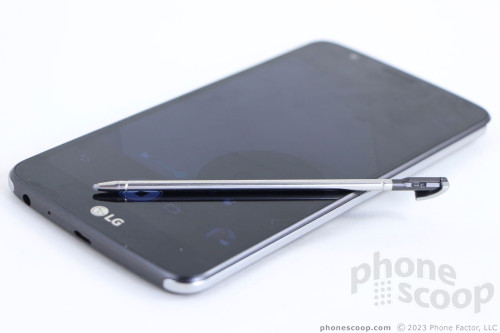
I like the faux brushed metal look of the rear panel. It spruces up the phone's appearance a bit — when it's not covered in finger oil. Seriously, LG should have given the plastic an oleophobic coating because it gets grimy and gross right quick. The camera module and screen lock button are packaged together in a long oval near the top of the Stylo 3's rear panel. The camera has a large round lens that protrudes a bit. An LED flash is tucked in between the camera and the screen lock button. The lock button itself is indented a bit, which makes it easy to find by feel. The button doubles as a fingerprint reader, which is a nice upgrade from the Stylo 2.
LG knows some people still care about removable batteries, and so the Stylo 3 has a removable rear cover and removable battery. A notch on the left edge of the phone gives your fingernail the leverage it needs to pry off the plastic. The plastic panel harkens back to the LG of old, meaning it's thin and doesn't inspire much confidence. With the panel removed, you have full access to the battery and SIM/memory card slots. You can swap memory cards without removing the battery, but the battery has to go if you want to get at the SIM card.
In sum, LG put together a solid piece of hardware in the Stylo 3. It won't be winning any design awards, and yet most people shopping for phones in this price range will be happy with their handset.
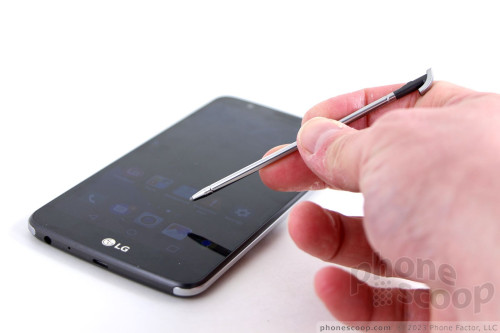
Screen
The display is a direct carry-over from last year's model, which means the Stylo 3 has a 5.7-inch LCD screen with 1280 by 720 pixels. It qualifies as HD, but the large size means those pixels are spread out. It's not the sharpest screen I've seen. It would have been nice to see LG upgrade the phone to full HD, but I understand that would have added significantly to the phone's cost. Colors are accurate on the LCD panel, but viewing angles aren't great. Last, the display is very reflective, more so than other phones I have on my desk, which makes it hard to see outdoors even when the brightness is set all the way up.
Signal
Boost Mobile operates on Sprint's LTE network and the Stylo 3 supports all of Sprint's major LTE bands. Moreover, the Stylo 3 supports 2 by 20 MHz carrier aggregation, which should translate to good data speeds. Even so, the phone performed on par with other Boost phones I've tested over the course of the last year. It doesn't match the performance of Sprint-branded handsets.
The phone was able to connect to the network everywhere I took it in the northern parts of New Jersey. It connected the majority of calls on the first dial, even under weak network conditions, and didn't drop any calls even when traveling at highway speeds. The phone may support Cat 6 LTE, but I wasn't impressed with data speeds. It certainly suffices for everyday activities, such as Facebook, Instagram, email, and browsing the web. I experienced a few blips when streaming music and video over the network, however, that give me a little cause for concern.
Sound
Call quality is a story of Dr. Jekyll and Mr. Hyde. The earpiece produces excellent voice calls. Clarity is fantastic, voices sound warm and present, and the phone pushes plenty of volume so calls can be heard in nearly any environment. I was able to hear and understand calls in quiet and loud spaces alike. I sounded "just ok" to others.
The speakerphone is an entirely different story. Clarity is barely acceptable at “low” to “mid” volumes, but the sound is barely audible. If you push the volume past the 60% mark, the speaker distorts horribly. Calls are completely unintelligible with the volume all the way up, you can't understand them at all. The speakerphone is workable in a very quiet room, but not anywhere else.
Ringers and alerts are loud enough to get your attention most of the time, but because they rely on the same speaker as the speakerphone, they sound like garbage. The vibrate alert is nice and strong.
Battery
The LG Stylo 3 excels when it comes to battery life. The phone packs a 3,200 mAh battery, which delivers well more than a single day per charge. I had a hard time killing off the battery over several days of intensive testing. The phone consistently had 30% or more capacity left at the end of the day, even when used with the screen brightness all the way up. Casual users will likely get up to a day and a half per charge from the Stylo 3.
The Stylo 3 has the basic Android power saver mode, which kicks on when the battery reaches 15%. When turned on, this automatically dims the screen, throttles down the processor, and cancels vibrate alerts. Thanks to decent battery life, I didn't need this tool while I reviewed the phone.
The phone doesn't seem to support any sort of rapid charging. I found it took several hours to power up with the included charger.
Bluetooth, GPS, NFC, WiFi
The Stylo 3's secondary radios all functioned properly. Bluetooth was a cinch to use. I made several calls via my car's hands-free system and they sounded so-so. Music had a rich sound when passed through a good Bluetooth speaker, but I've heard better. The phone had no issue connecting to other phones, accessories, and PCs.
Google Maps and the Stylo 3's GPS radio were bosom buddies. The phone located me within seconds and was accurate to about 10 feet. That's excellent. Real-time navigation between points worked flawlessly.
The WiFi worked just fine. The Stylo 3 doesn't have NFC.
Software
Lock Screen
LG's take on the Android lock screen offers more flexibility than most. The Stylo 3 includes KnockOn and Knock Code for waking and unlocking the phone.
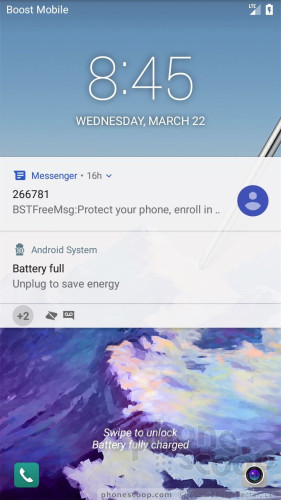
KnockOn will wake the display when the Stylo 3 is double-tapped. You see the clock/notification combo at the top of the screen, in addition to shortcuts for voice search, phone, messaging, photo gallery, and the camera. KnockOn is most helpful when the phone is sitting on a table or desk.
KnockCode is a security tool you can select to wake and unlock the phone in one step, through a custom pattern of taps.
I like that the lock screen clock is big and bold. This makes it easier to see, especially when outdoors. Users can fine-tune notifications for each individual app on the phone, which means plenty of control over what pops up in the screen.
Security options include PIN, pattern, password, and print. The fingerprint reader, like most these days, is easy to train. It takes about a minute to setup each print. The phone allows you to store up to five prints. Given the rear position of the fingerprint reader it's best to pick your two index fingers as the primary prints. The reader is quick and accurate, which is all I need. I particularly appreciate that LG allows Stylo 3 owners to separately protect photos and QuickMemo files with a fingerprint.
Home Screen
The Stylo 3 runs Android 7 Nougat with LG's user interface on top. There are three home screen panels active when you first boot the Stylo 3 and they are crammed with Boost Mobile apps, widgets, and shortcuts.
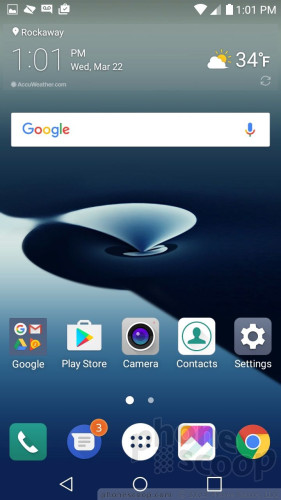
By default, there's no app drawer, so all installed apps live somewhere on a home screen. But you can turn on the app drawer if you prefer a cleaner home screen. The home screens can be tweaked however you might like. I appreciate that apps can be arranged in various grid configurations (4x4, 4x5, 5x5) on the home screen. This lets you make more effective use of the large screen's real estate.
If you choose to turn on the app drawer, you'll find you can hide apps you know you won't use often, and easily bring them back when needed. You can automatically re-sort apps to appear alphabetically, by frequency, or by install date.
The phone lets you manage options such as button arrangements, screen transitions, fonts, font sizes, and more. There are a few themes on board, too.
LG included EasyHome with the Stylo 3, which simplifies the user interface for users not used to the full Android experience. This might be ideal for certain older users with poor vision buying the Stylo 3 for its large screen. But the majority of people who buy the Stylo 3 can skip EasyHome.
The Stylo 3 supports split-screen multitasking, as well as miniaturized apps optimized for one-handed use. In other words, you can reduce the size of apps on the screen, and they tuck themselves into one of the lower corners, so they are easy to use.
The Quick Settings panel includes five toggles across the top, as well as a slide to control screen brightness. You can customize which toggles appear in the Quick Settings screen and swipe the toggles down to see more controls. The panel also allows you to access, act on, and dismiss notifications.
The main settings tools are broken down into several tabs by default, though you can adjust them so they appear on a single screen. I found the settings easy to use.
The Stylo 3 upgrades to a Snapdragon 435 processor, but keeps the Stylo 2's 2 GB of RAM and 16 GB of internal storage. These are becoming dated specs these days, but worse, the Stylo 3's software takes up more space than that of the Stylo 2, which means you have less storage available out of the box. You're going to need a memory card with this phone. The processor pulls its weight. The Stylo 3 never felt sluggish or slow, screen transitions were smooth, and apps opened quickly.
Stylus
Pulling out the stylus automatically turns on the screen. Once unlocked, a stylus menu pops up in the upper right corner with several options. The first four options are set by LG; you can choose the fifth.
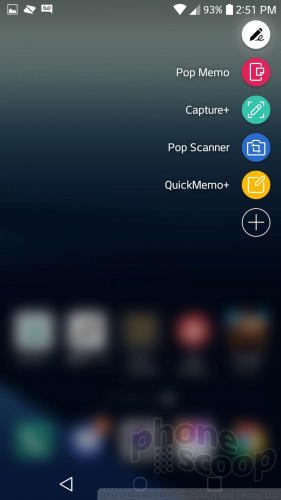
Each of the stylus-oriented apps does something similar. The first, Pop Memo, is a simple app for scribbling memos. You can adjust the pen color, but that's about it. The second option, Capture+, takes a screenshot and immediately loads it into the QuickMemo editing tool. The Pop Scanner option opens the camera and allows you to take pictures that are then automatically inserted into QuickMemo. Last, the QuickMemo+ app itself is listed. Choosing it opens a blank memo.
I'm disappointed that LG hasn't taken these stylus-specific apps further. They are largely carried over from last year's phone and don't offer any obvious new functionality.
Other than this set of tools, the stylus doesn't have any other special apps. It works just like your finger and interacts with everything on the phone as if it were the tip of your index finger. The only benefit to using the stylus over your finger is the stylus can be more precise. I particularly like using the stylus for entering text on the keyboard.
Camera
The Stylo 3 doesn't have a physical camera button, though you can launch it from the lock screen or with a quick double press of the volume-down button. The camera interface is pretty straightforward for a modern phone.
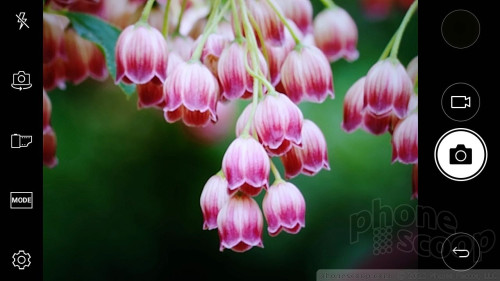
A batch of basic controls runs down the left side of the main screen and includes flash controls, user-facing camera, film effects (filters), shooting modes, and settings. None of these buttons cannot be customized. The shutter buttons are on the right. Shooting modes are sadly limited to auto and panorama. HDR is only available via the settings menu. You can set HDR to “auto”, but I wish an HDR toggle was accessible from the main viewfinder. The Stylo 3 lacks fun stuff like timelapse and slow-mo.
The camera settings menu is easy to decipher. It allows you to adjust image and video resolution, as well as turn on/off geo-tagging, the timer, the grid, and image stabilization.
The user-facing camera includes beautification filters and LG's selfie shot tool, which lets you snap a shot by making a fist gesture and then opening your hand (this starts a timer).
The Stylo 3's camera software is relatively quick to focus and snap photos. The tap-to-focus function is particularly fast.
Photos / Video
The Stylo 3's 13-megapixel camera takes average photos. I wasn't disappointed, nor was I bowled over.
Some photos were perfectly in focus, while others were soft. Some were nice and sharp, while others were saturated with grain. Some were properly exposed, while others were over/under-exposed. Low-light shots were consistently grainy. Colors look pretty good thanks to accurate white balance. Even with HDR set to auto, the Stylo 3 struggled to balance high-contrast scenes. It gets the job done, but not in an impressive way.
The 5-megapixel selfie cam actually does decent work. You can see in the sample below the sharp focus and good exposure despite the bright highlights and shadows.
The phone captures either 1080p or 720p HD video. The 1080p stuff looks good. I was pleased with focus, color, and exposure when shooting some clips. If you're indoors you'll see more grain for sure.
The Stylo 3 suffices for everyday shooting, but I wouldn't trust it with vacations, weddings, or other important stuff you want to preserve.
Wrap-Up
LG's Stylo 3 is a decent mid-range handset. The phone is a bit boring to behold and yet it still manages to stand out thanks to the large footprint and stylus. You'll find average-quality materials and appointments on the Stylo 3. The big display has a mediocre resolution and isn't as bright as I'd like it to be. As long as you make calls through the regular earpiece and not the speakerphone you'll be happy with their quality. Data speeds left me unimpressed, but the battery life is to die for. I found the camera app to be responsive. It's a shame that the resulting pictures are so so-so.
Thankfully the software outshines the hardware to a degree. It's great to see Android 7 on board the Stylo 3, and LG's advanced user interface skin gives owners wide latitude to make the phone their own. You can choose from three basic home screen styles and adjust each, as well as apply themes, customize button placement, and more.
It's nice to have the stylus and dedicated software, and yet LG could have done so much more with it.
Boost Mobile is selling the Stylo 3 for $180, which is a fair price considering what the phone delivers. If you value screen size and battery life over premium design and camera results, the Stylo 3 fits the bill for not too many bills.

Comments
Storage?
The Stylo 2 didn't let users store apps on the SD card like many Androids do. This, in addition to the myriad preloaded, non-uninstallable apps caused major issues with storage in the previous model. Did LG correct this with the Stylo 3?


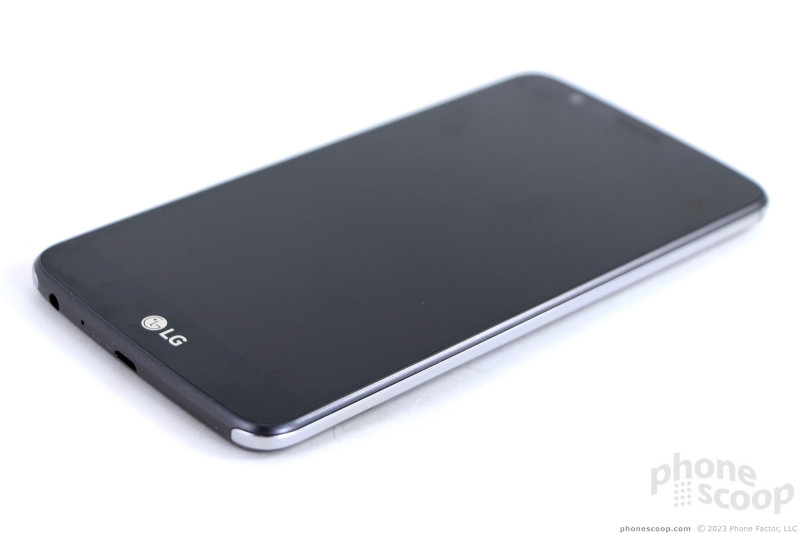


















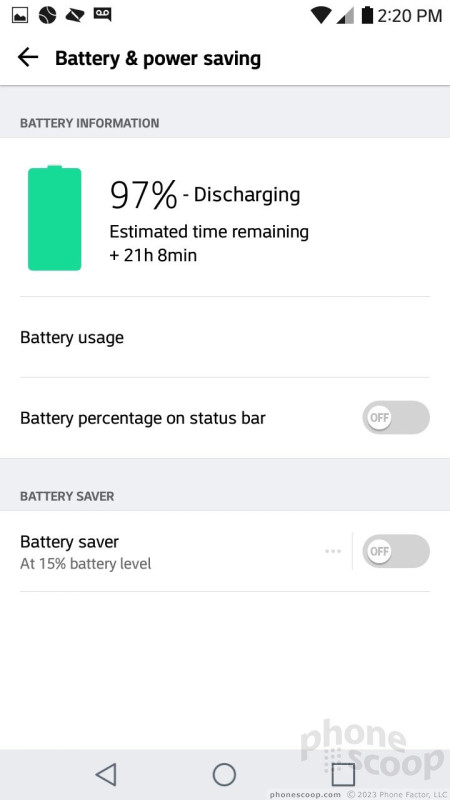



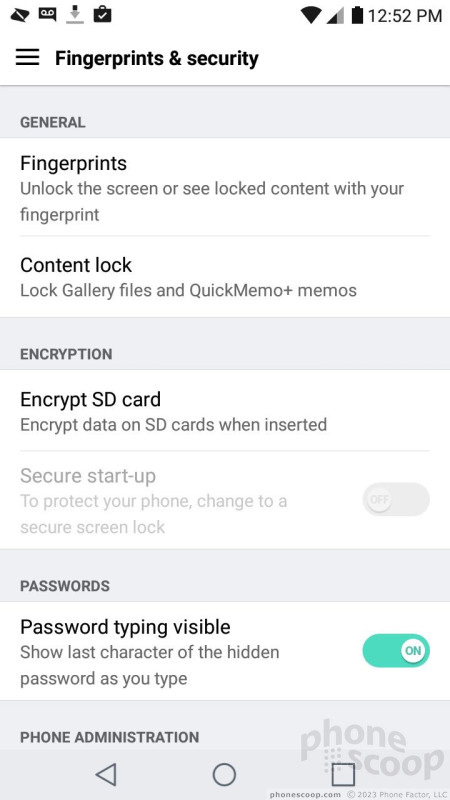






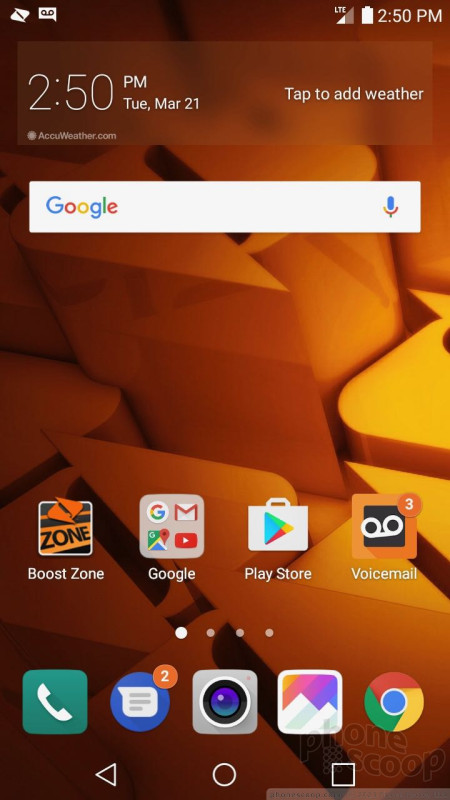










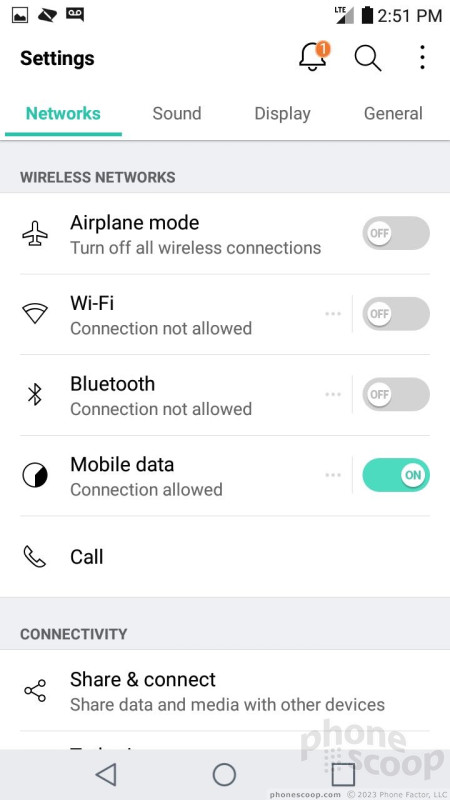














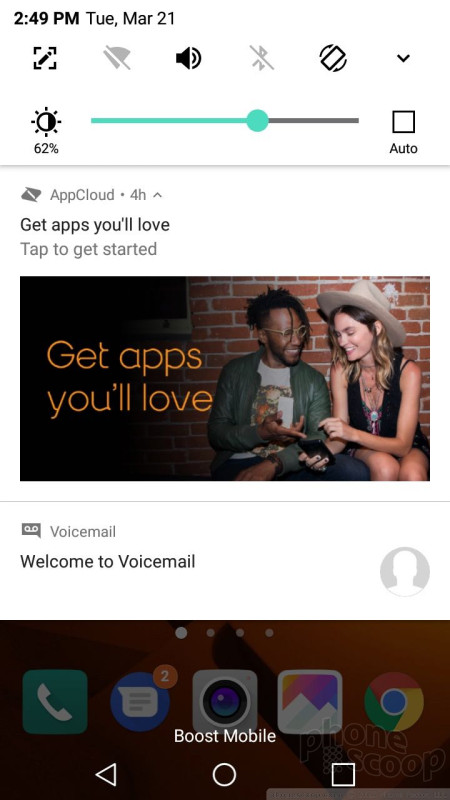





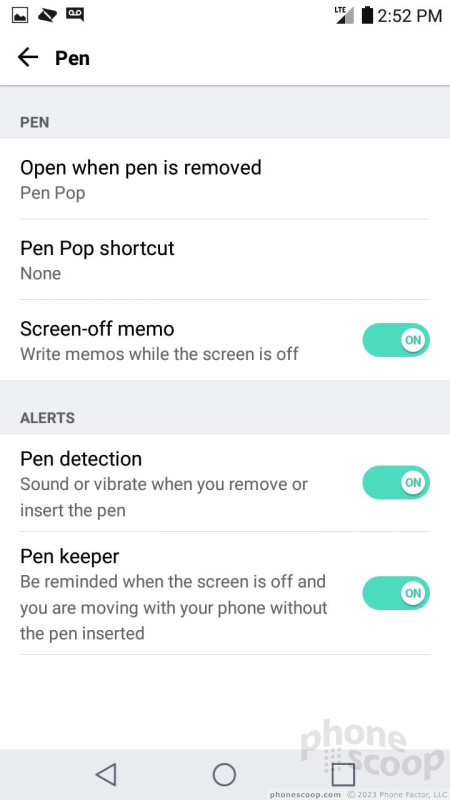















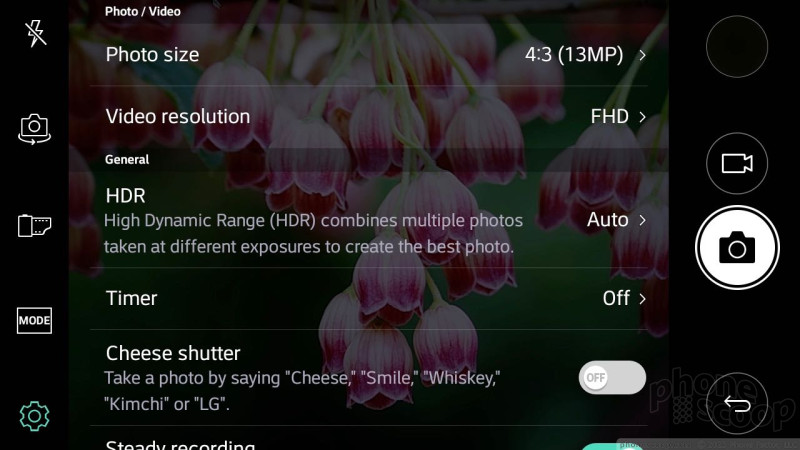




















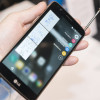 Hands On with the LG Stylo 3
Hands On with the LG Stylo 3
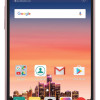 Cricket to Sell LG Stylo 3 Starting May 19
Cricket to Sell LG Stylo 3 Starting May 19
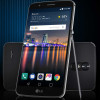 Boost and Virgin Mobile Selling LG Stylo 3 for $180
Boost and Virgin Mobile Selling LG Stylo 3 for $180
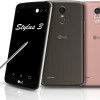 LG Debuts Third-Generation Stylus Smartphone
LG Debuts Third-Generation Stylus Smartphone
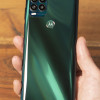 Hands On with the moto g stylus 5G
Hands On with the moto g stylus 5G
 LG Stylo 3 (CDMA)
LG Stylo 3 (CDMA)




